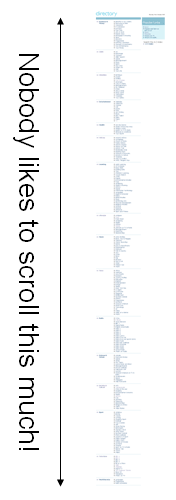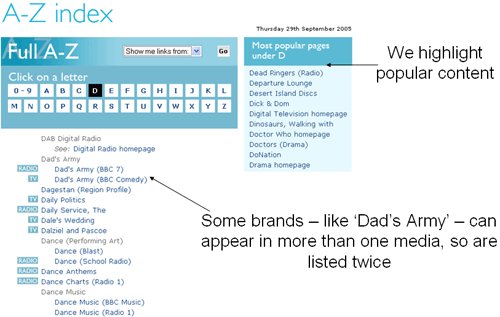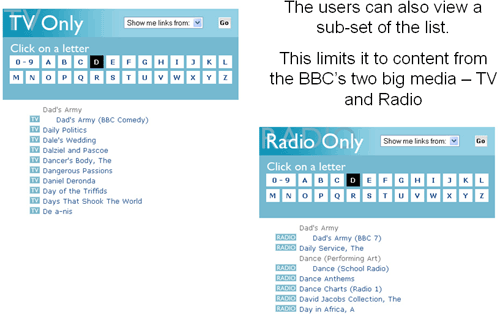Managing 'Glue' at the BBC: Classification - part 4
This is page 4 of a 5 page article - 1 2 3 4 5
![]() Download a print version of this article
Download a print version of this article
Classification
I want to talk a little bit now about some of the classification of content that we do on the BBC site.
We have a real problem, in that we want to make everything simple and easy for people to understand, but at the same time we have been charged by the government to show the breadth and depth of our content, which as I said is over 2 million pages.
So we end up with things like the BBC Directory, with 14 top-level categories as follows:
- Business & Money
- CBBC
- CBeebies
- Entertainment
- Health
- History
- Learning
- Lifestyle
- Music
- News
- Radio
- Science & Nature
- Society & Culture
- Sport
- Television
- World Service
Even to the untrained eye there are some serious flaws in the top level classification schema illustrated here.
To highlight a couple of them, the World Service is a radio station, so why is it classified as a top-level category in its own right, rather than a sub-category under Radio where all of the other radio stations sit? CBBC and CBeebies are two television channels aimed at children. So why are they not either under one Children's category, or sitting under the Television category with the BBC's other channels?
The answers are to do with the branding and the politics of the BBC as an organisation. The World Service is funded separately from the Licence Fee funded content on the BBC web site, so needs to be made distinct from the UK focussed public service offering. CBBC and CBeebies are aimed at very different audience age groups, and from a marketing point of view it has been important for the BBC to distinguish them as separate entities.
So you can see already that the whole of the current classification schema has been compromised by the priorities of the business taking preference over the priorities of the information professional.
There is another problem with this as well. We have a one page directory for the whole site, and of course, everybody within the business wants their content to appear in it. We end up with a page with 245 links on it. To shrink it down to the size that will fit on a PowerPoint slide or be an illustration in an article makes it completely unreadable. The page ends up as very little use to anyone, with too many links and too much scrolling.

Fortunately we do at the BBC have some people who understand the need for usable classification, so alongside the politically driven Directory, we also offer a comprehensive A-Z index of the website. This also has a spin-off benefit for us, because it means it is very easy for search engine spiders to reach and index all of our content.
Each page on the A-Z lists everything we have on the site for the letter either by name or category. We also have a section for 'popular content' from that page to try to prevent people having to scroll too much through the content. We measure what is popular by what people are searching for and by the page impressions that the content generates.

You can see that some brands, like 'Dad's Army' appear on more than one of our services, so we have to list them in more than one place. Although it is primarily known as a television show in the UK, some of the early episodes of Dad's Army have been lost. However, the soundtracks survive in off-air recordings, and some of these have been broadcast on the BBC's digital radio speech and archive station, BBC7. We therefore have two entries for the brand in the A-Z.
We also allow the audience to divide the A-Z into sub-sets of our two main broadcast media, TV and Radio. You can see that Dad's Army appears on both the D - TV subset and the D - Radio subset. This gives our users an extra way of navigating through the BBC's online content.

The BBC's New Media department is also now working on a new top-down classification system. By top-down, I mean a way of organising the site into broad high level categories, rather than a granular analysis of exact content types.
In fact we do this probably every two or three years, using Information Architects to devise an ideal way of organising the site, and then using managers and marketers to look at it and work out the areas where you can't do x or y for business reasons.
The new scheme is different, however, as it attempts to classify the site in a multi-faceted way. This means that individual URLs can appear in several areas of the classification.
First of all the content is divided by broadcast medium, so essentially whether it is a TV programme or Radio show. The classification then also defines content by whether it is a 'frequent task', and this consists of primarily time-based content that the BBC brand is very heavily associated with in the UK, like News, Sport and our British obsession with the Weather.
The classification scheme then identifies content that can be grouped by topic, so things like 'Lifestyle' i.e. gardening, D.I.Y., 'Knowledge' which includes educational content, science, nature and history, and finally 'Entertainment'.
The intention is also to divide content by audience, and you can see again that the BBC has not been able to have one unified set of children's content, but the content will be divided between 'for kids' and 'for teens'.
The scheme also specifies an area for parts of the BBC website that are defined by the nature of their two-way interaction with the audience. 'Talk and Interact' covers our message boards and sites that are hubs for user-generated content like h2g2, Island blogging or the Peoples War.
We also intend to classify content by its regional location in the UK.
So for example if you had a TV programme that was 'entertainment', aimed at a children's audience, and made by BBC Wales, it would appear in four of these category sections. We hope therefore to allow users a much better way of navigating through the BBC to specific bits of content through the route that they find easiest, not through the route that the BBC as a business finds it easiest to organise on the users behalf.
We are also trying new ways to make this easy for the audience to understand. We will shortly be launching a couple of areas on bbc.co.uk where this new classification schema is exposed to the audience, and we hope to do it in a user-friendly way with clear iconography and simplified language to help them understand the concepts the categories represent. It is all very well investing the time and effort to precisely define things, but if it isn't the language and vocabulary used by our audience they won't understand it and it won't be a help to them.
Continue to find out some areas of development on bbc.co.uk and backstage.bbc.co.uk which might represent the glue that the BBC will use in the future to present content to the audience.